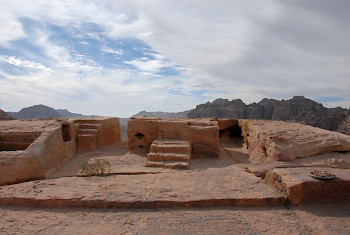High Place of Worship
High Place of Worship: modern name for the ancient mountain sanctuaries in the Near East.

Although the ancients knew that the earth was spherical, there were always traces of the old notion that its shape resembled a dish. The sky and the lowest heavens were nearby, the gods above were nearby too. It was only logical to build an altar and say prayers on the top of a hill or mountain, as close to heaven as one could be. It's why the Mesopotamians built ziggurats.
Mountain sanctuaries are known from all over the Near East. The most famous one is the High Place of Worship in the Nabataean capital Petra, but the altars in Faqra and Temple D in Sfiré (both in Lebanon) and the Umm Daraj sanctuary near Dedan (Saudi Arabia) are other examples. The concept is also known from the Bible, which refers several times to the bamot, the "high places".note The story of the aqedah ("the sacrifice of Abraham") takes place on a mountain in a land called Moriah.note
The Life of Apollonius by the Athenian author Philostratus (third century CE) contains a short dialogue about the proximity of the gods on high peaks, leading to the conclusion that mountaineering does not benefit those in search of the divine.note